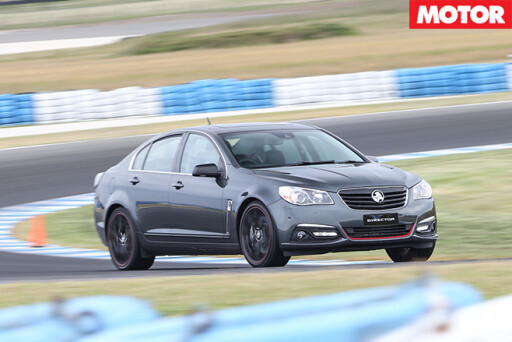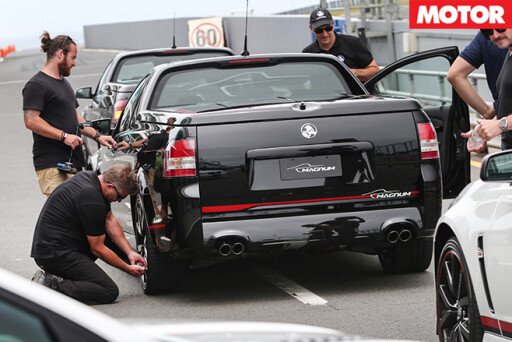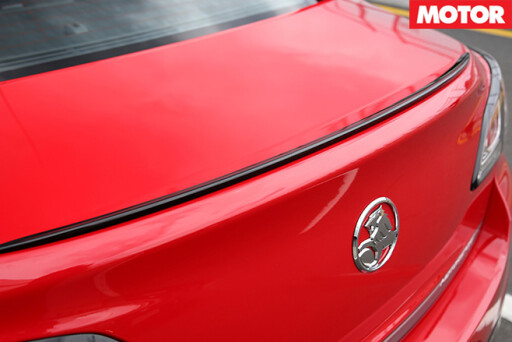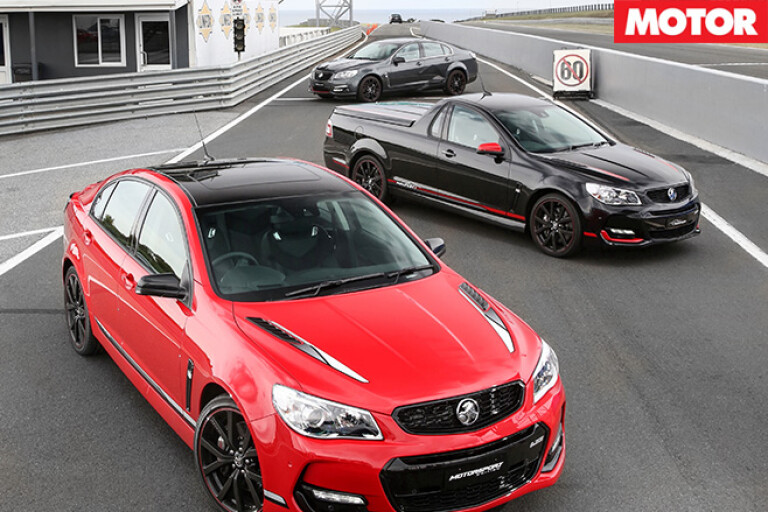
Plenty of folks have done what they thought was the smart thing: they snapped up a VF Series 2 Commodore SS or SS-V and hid it away, figuring the last SS Commodore will have to be worth money in the not-too-distant.
Thing is, they might have jumped the gun. See, taking a leaf out of Ford’s book, Holden has saved a handful of special, final-edition models till the last gasp of local production. You can order them from early 2017, but you won’t take delivery until the middle of the year.
And, if anything, they’re going to be even more collectible than those last SS and SS-Vs. How come? Because – like the Falcon XR8 and XR6T Sprints – the last performance Commodore Special Editions (as Holden is calling them) will be just that – a bit special. Or a lot special. Depends on how you look at it.
 The Special Editions amount to two sedans and a ute, but with added spice and a strictly limited production run. As well as one-off fitments, there’s a personalised buying experience. And on top of that, Holden has borrowed a few bits and pieces from some of its Stateside models, the addition of which bestow GM’s Level Three Track Competent status, something otherwise reserved for the likes of the Camaro ZL1.
The Special Editions amount to two sedans and a ute, but with added spice and a strictly limited production run. As well as one-off fitments, there’s a personalised buying experience. And on top of that, Holden has borrowed a few bits and pieces from some of its Stateside models, the addition of which bestow GM’s Level Three Track Competent status, something otherwise reserved for the likes of the Camaro ZL1.
The first model is called the Motorsport Edition. It’s based on an SS-V Redline, which means it gets the big Brembos and the 304kW 6.2-litre engine that we’ve been raving about since we first drove it a year or so ago. On top of that, it gets Magnetic Ride Control from HSV with three distinct damper settings.
The Tour setting amounts to a damper consistent with the standard Commodore FE2 set-up, while flipping the switch to Sport gets you the equivalent of FE3. Turn the knob all the way to Performance and it’s tighter again while the Track setting is the Performance damper rate but with ESP disabled. The bi-modal exhaust valve, steering assistance and throttle sensitivity are also all linked to the driver-mode switch.
 There’s also a new rear cradle bush with a much higher deflection-force rate, which is also a constant radial rate unit so it no longer behaves differently in a fore-aft plane versus the lateral plane. Cross-drilled rotors front and rear join the Brembo calipers and, with a two-piece design with alloy top-hats, they reduce the unsprung mass across the front axle by 3.5kg.
There’s also a new rear cradle bush with a much higher deflection-force rate, which is also a constant radial rate unit so it no longer behaves differently in a fore-aft plane versus the lateral plane. Cross-drilled rotors front and rear join the Brembo calipers and, with a two-piece design with alloy top-hats, they reduce the unsprung mass across the front axle by 3.5kg.
But probably the biggest news is the addition of a driveline cooling package that includes engine-oil and transmission-oil cooler units and it’s this fitment that takes the Holden to GM’s Level Three track-readiness rating.
They're lifted from the Camaro ZL1, and if the external coolers can keep GM’s 11-second monster cool, they should work here, too. Other additions include a black roof, shift paddles with the auto and 20-inch lightweight alloys. A pair of specific (and heated) front seats are also part of the deal.
 The second of Holden's Special Editions is slightly more subtle. Based on the Calais-V, the Director gets the same Magnetic Ride tech as the Motorsport Edition, the same brake enhancements and the identical powertrain cooling package. It also gets a black roof, shift paddles for the six-speed auto, specific front seats and those forged 20-inch wheels.
The second of Holden's Special Editions is slightly more subtle. Based on the Calais-V, the Director gets the same Magnetic Ride tech as the Motorsport Edition, the same brake enhancements and the identical powertrain cooling package. It also gets a black roof, shift paddles for the six-speed auto, specific front seats and those forged 20-inch wheels.
Both the Motorsport and Director come with a fairly subtle lip spoiler for the bootlid, but there’s a proper wing optional on the Motorsport. The Director also picks up the SS’s bonnet vents.
The third member of this unholy trinity is the Magnum (yet another nod to Brock’s famous models) Ute, based on the SS-V Redline Ute. Because of the architecture involved, the Magnum misses out on the Magnetic Ride gubbins, but it does pick up the equivalent of an FE3 tune for its rear-end.
 The idea is to give it more car-like ride and handling while recognising that high-end utes like this one rarely, if ever, have a cubic-metre of topsoil in their trays. The changes involve a reduction in rear spring rate (26 per cent down), 10mm shorter dampers and 15mm lower rear ride height. As a result of the tweaks, the payload has reduced from 620kg to 540; down some but still enough for a dirt bike, a swag and an esky.
The idea is to give it more car-like ride and handling while recognising that high-end utes like this one rarely, if ever, have a cubic-metre of topsoil in their trays. The changes involve a reduction in rear spring rate (26 per cent down), 10mm shorter dampers and 15mm lower rear ride height. As a result of the tweaks, the payload has reduced from 620kg to 540; down some but still enough for a dirt bike, a swag and an esky.
Meanwhile, the Magnum picks up the cross-drilled rotors, powertrain cooling kit, upgraded seats (from a Calais V) a hard tonneau, and those 20-inchers.
Now, you might be sitting there thinking that the changes Holden has carried out don’t amount to much considering Ford went to the trouble of actually turning up the wick on its own, XR8 Sprint, equivalent of saving-the-best-till-last. But that would be ignoring the fact that your basic Commodore SS-V Redline or Calais V was already so far ahead of the bread-and-butter XR6 and XR8. And let’s not forget that Holden had to resist the urge to go too crazy and trip over anything HSV might have had in the pipeline, too.
 As it is, the improvements are relatively subtle, but equally meaningful. And that much is obvious from the moment you stab the buggers in the throttle and roll out on to the road or, in our case, the Phillip Island GP circuit. It is possible to drive one of these cars in Tour mode on a race-track, but to do so would be inviting ridicule and letting down your whole family.
As it is, the improvements are relatively subtle, but equally meaningful. And that much is obvious from the moment you stab the buggers in the throttle and roll out on to the road or, in our case, the Phillip Island GP circuit. It is possible to drive one of these cars in Tour mode on a race-track, but to do so would be inviting ridicule and letting down your whole family.
So I skipped Sport even (which at least opens the exhaust valve) and went straight for Performance. And from there, Track is but a couple of taps of the mode selector away with the added benefit that you’ve also disabled ESP. For once, my family can be proud of me.
To be honest, there’s not a whole lot of difference in the way the Motorsport and Director drive, provided your Motorsport is running the six-speed slushbox. True, the Director lacks that extra stiff rear-cradle bush, but Holden’s lead development engineer for this project, Dan Pinnuck, admits that you’d have to be “doing something fairly extreme to notice the difference”.
 But the Magnetic Ride stuff? Well, that’s another story, because the sharpest damper setting really gives the big girl some sidestep on the circuit. There’s a bit more control right at the limit and that means the limit goes from ragged edge to a progressive loss of adhesion that you can easily counter by growing a slightly less stupid right foot. But even better is that, along the way, the Commodore’s front end has managed to retain that lightness of being that makes it a delight even in boggo SS form.
But the Magnetic Ride stuff? Well, that’s another story, because the sharpest damper setting really gives the big girl some sidestep on the circuit. There’s a bit more control right at the limit and that means the limit goes from ragged edge to a progressive loss of adhesion that you can easily counter by growing a slightly less stupid right foot. But even better is that, along the way, the Commodore’s front end has managed to retain that lightness of being that makes it a delight even in boggo SS form.
Our pick would be the Motorsport manual, purely because being able to pluck gears at redline is (a) totally satisfying and (b) gives you that little edge in outright control by not having to second-guess the tranny. That said, the auto does obey your commands via the paddles, but it’s not always quite as instantaneous as you might like. But whichever transmission you opt for, you’ll be amazed at how precise and tight such a big, heavy car can feel. The move to add the driveline coolers makes sense, too, because it’s now that you realise that these are actually decent track-day cars.
If anything, the Magnum Ute is even more of a surprise-and-delight deal. Not that it’s going to be any faster than the other two, but simply that it’s probably come further in terms of its track-readiness. The changes to the rear end to soften it have worked wonders and there’s now even more power-down and ability to launch itself out of a turn.
 Now, you might imagine the extra wheelbase (the ute has 3009mm versus the sedan’s 2915mm) would make the Magnum a bit lazier and slower to rotate. If it is, we couldn’t pick it. But while the Magnum is just as agile, that extra length between the axles does make it simpler to drift with fewer consequences than you get with something a bit twitchier.
Now, you might imagine the extra wheelbase (the ute has 3009mm versus the sedan’s 2915mm) would make the Magnum a bit lazier and slower to rotate. If it is, we couldn’t pick it. But while the Magnum is just as agile, that extra length between the axles does make it simpler to drift with fewer consequences than you get with something a bit twitchier.
And here’s how you know the driveline cooling work has been worthwhile: we caned these cars around Phillip Island for about three hours in 30-something ambient and high humidity. And despite having no cool-down between stints, not a single car spat a drop of coolant, nor did a single tranny get hot enough to prompt the ECU into limp-home made.
So what’s the price of all this specialness? Well, both the Motorsport in automatic form and the Director (which is auto only) are $63,990, which represents a hike over the auto SS-V Redline and the Calais-V at $56,690 and $55,990 respectively. The Motorsport Edition with the manual saves you a couple of grand ($61,790). But you are getting a fair bit more hardware, including that US-spec cooling system that suddenly makes these cars track-realities, if that’s your thing.
 The Magnum trayback lands at $59,290 with a clutch pedal and $61,490 without it, again, a fair chunk over the SS-V Ute ($50,990 and $53,190). And while you miss out on Magnetic Ride, it’s possibly even more of an improvement over the donor car.Meanwhile, don’t lose sight of the fact that it’s these three models that will go down in history as the last hurrahs for the Commodore franchise, deliberately so at that.
The Magnum trayback lands at $59,290 with a clutch pedal and $61,490 without it, again, a fair chunk over the SS-V Ute ($50,990 and $53,190). And while you miss out on Magnetic Ride, it’s possibly even more of an improvement over the donor car.Meanwhile, don’t lose sight of the fact that it’s these three models that will go down in history as the last hurrahs for the Commodore franchise, deliberately so at that.
Holden’s general manager for product marketing, Ben Lasry put it in simple terms: “Our goal was to build the best Commodore we’ve ever built. This is one for the enthusiasts.”
The significance of these cars is not lost on Dan Pinnuck, either: “These are cars that show our appreciation of what [the Commodore] represents.” I’m not in a position to argue those points.
The other thing you can’t argue with is exclusivity. And with just 1200 examples of the Motorsport Edition (plus 151 for New Zealand) 360 Directors (51) and just 240 Magnums (51) these things won’t be common. The real danger, of course, is that they’ll be so utterly collectible, they’ll never be seen on the streets. Which would be a crying shame but, at the same time, some kind of mournful metaphor for the whole local car-making shebang.

SS-V REDLINE MOTORSPORT
Body: 4-door, 5-seat sedan
drive: rear-wheel
engine: 6162cc V8, OHC, 16v
bore/stroke: 103.1 x 91.4mm
compression: 10.7:1
power: 304kW @ 6000rpm
torque: 570Nm @ 4400rpm
power/weight: 169kW/tonne
transmission: 6-speed manual
weight: 1793kg
Front suspension: struts, coil springs, anti-roll bar
Rear suspension: multi-links, coil springs, anti-roll bar
L/W/H: 4964/1898/1471mm
Wheelbase: 2915mm
Tracks: 1593/1590mm (f/r)
Steering: electrically-assisted rack-and-pinion
Front brakes: 355mm ventilated discs, 4-piston calipers
Rear brakes: 360mm ventilated discs, single-piston calipers
Wheels: 20 x 8.5-inch (f); 20 x 9.5-inch (r)
Tyres: 255/35 ZR20 (f); 275/35 ZR20 (r) Bridgestone Potenza
Price as tested: $61,790
Pros: Worthwhile upgrades; collectibility
Cons: Bowing out when it's better than ever
Star Rating: 4.5

COMMENTS